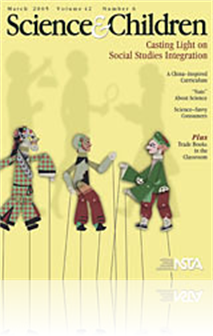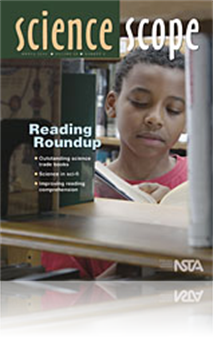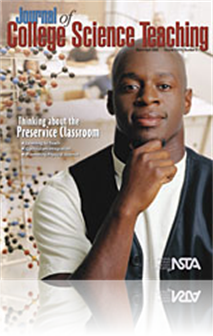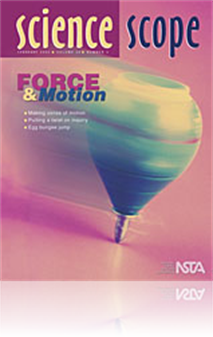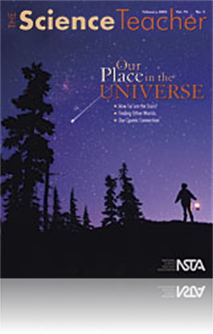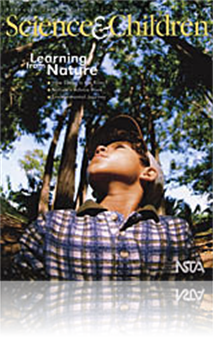All Resources
Journal Article
Have you ever wondered how the mountain of trade books out there gets evaluated or how books are chosen as "outstanding"? This list doesn't just magically appear but is the result of a careful evaluation process by the NSTA/Children's Book Council Jo...
Journal Article
Career of the Month: Scientific Illustrator
If your students' have an eye for nature's details--such as the way some petals of a flower catch sunlight or how its stem is covered in tiny hairs--then they may be a good candidate for a career in Scientific Illustration. Introduce your high schoo...
Journal Article
Science Shorts: Tarred and Feathered
We rely on the transportation of oil around the world to meet our energy needs. Oil is carried across the oceans on large ships called tankers. Unfortunately, sometimes things go wrong and oil spills occur, putting great stress on wildlife, especia...
Journal Article
Field Ecology in a Cultural Context
Ecological studies that examine how organisms interact with their environment provide a particularly useful backdrop for high school students to both quantitatively and qualitatively explore the natural world. In Hot Springs, South Dakota, the author...
Journal Article
Reading & Writing Nonfiction with Children: Using Biographies to Learn about Science and Scientists
Students are introduced to real life accounts of scientists in this fun and hands-on activity. Through biographies, students identify examples that reflect aspects of the nature of science and scientists. Pop-up books are used to expand students' un...
Journal Article
Help students make real-world connections to Earth science concepts such as volcanoes with the help of modern technology. This article enumerates several websites where students can explore these forces of nature in a variety of ways - all from a sa...
Journal Article
Savvy Consumers Through Science
Is Bounty the "quicker picker upper?" Are expensive shampoos better? Are all antacids the same? Fourth grade students posed and answered these questions during a "Consumer Product Testing" unit in which they designed experiments to assess these pr...
Journal Article
This study examined the effect of physical and virtual field trips on undergraduate, nonscience majors. No significant differences were seen in achievement, attitudes, learning styles, interactions between field trip and learning styles, or students�...
Journal Article
Mathematics in the Biology Classroom: A Model of Interdisciplinary Education
This article describes an interdisciplinary course that develops essential mathematical modeling skills within an introductory biology setting. The course embodies recent recommendations regarding the need for interdisciplinary, inquiry-based mathema...
Journal Article
A Decade of Concern: A review of multicultural science education issues in the The Science Teacher
Multicultural science education has long been of interest to the National Science Teachers Association (NSTA). As a result, The Science Teacher has devoted one issue each publishing year to multicultural science education. This article examines the i...
Journal Article
Outstanding Science Trade Books for Students K-12 (2004 List)
The annual list of Outstanding Science Trade Books for K-12 students was selected by a committee of National Science Teacher Association members. This comprehensive list of selected books were all published in 2004....
Journal Article
Scope on Safety: Greener is cleaner, and safer
Indigenous people of many continents have practiced the concept of going"green" for centuries--you should too! Green chemistry, or sustainable chemistry, substitutes nonhazardous chemicals for those that pose high risks, thereby reducing the quanties...
Journal Article
Idea Bank: Interview Assessment
Do you worry that your high school chemistry students are not learning enough from lab activities? If so, it is possible that they aren't learning enough from writing basic lab reports. To encourage concept retention among students, try using Intervi...
Journal Article
Science Sampler: Content Reading Strategies
Since effective reading and comprehension skills impact achievement in science, this collection of reading content strategies will be useful in helping students improve reading skills before, during, and after an exercise. ...
Journal Article
Have you ever wondered how the mountain of trade books out there gets evaluated or how books are chosen as "outstanding"? The Outstanding Science Trade Books (OSTB) for Grades K-12 doesn't just magically appear but is the result of a careful evaluat...
Journal Article
A Rationale for Cultural Awareness in the Science Classroom
Across the United States, only 10% of all teachers are members of minority groups, indicating that teachers are far less diverse than the current populations of students they teach. The danger of this disparity is that the delivery of academics may h...
Journal Article
Are They Really Learning What We're Teaching? An Informal Survey and Student Self-Assessment
While enrolled in either the first or second semester of a two-semester human anatomy and physiology sequence, students self-assessed their mastery of material presented in the prerequisite course. Fifty-seven percent of the students reported that th...
Journal Article
Editorial: Tsunamis and Other Disasters -- A Response from Scientists Who Teach
Scientists who teach have a unique opportunity and an ethical obligation to ensure that the scientific and technical basis for analyzing natural and man-made threats is communicated to citizens. As predictions are borne out, scientists need to think...
Journal Article
Favorite Demonstration: Mock Immunoprecipitation - "Who Done It?"
Many biologists have admitted that much of what is taught in biology is explained with principles of chemistry and physics. Chemistry and physics demonstrations work as well in biology teaching as they do in their respective disciplines. The demon...
Journal Article
In science, students learn about their place in the natural world. In social studies, they learn about our social systems and history. Both are vitally important subjects. What better way to "prepare students to lead personally fulfilling and resp...
Journal Article
Libros de Ciencias en Español (2005)
This article lists the current trade books in Spanish useful for young learners. Books are grouped under such categories as For the Very Young, Biology, Technology, and Physical Science....
Journal Article
This creative activity weaves science fiction and language arts skills into the science classroom, which can expand and enrich the science content and abstract concepts found in science textbooks.Well-written literature can be used to open new ways o...
Journal Article
A multidisciplinary learning community provided environmental management students the opportunity to work with students in different classes and majors to create designs for improving the appearance and environmental quality of a lake on a university...
Journal Article
Point of View: So Tell Me Again--Who's Locked in the Chinese Room?
To succeed in our classes--especially science classes--students must be physically and intellectually present most of the time. They must be able to solve problems with minds and with hands and with others. They have to have some level of facility ...
Journal Article
Science Sampler: First-class inquiry
In this scientific inquiry-based activity, students explore how variables in a first-class lever, specifically arm length, position of the fulcrum, and placement of the load, affect the effort needed to lift the load....
Journal Article
Ask the Experts -- February 2005
The Experts will provide the answers to your burning science questions! In this month's column, they answer the questions, What is a black hole? and Can a black hole pull in another black hole?...
Journal Article
After studying linear motion and learning the basic concepts involved, (inertia, force and motion, friction), middle level students can apply their learning to nonlinear situations. Using toy tops is one way to teach students the basic concepts of no...
Journal Article
Commentary: Professional Development and Resources for Educators in Astrobiology
In addition to catalyzing and promoting interdisciplinary research in astrobiology, the NASA Astrobiology Institute (NAI) also seeks to train the next generation of astrobiologists. To accomplish this, NAI provides a wealth of resources and support f...
Journal Article
A yearlong river study builds science-process skills and understanding of basic water quality concepts. Third-grade students set out to determine the health of a local stream, practice several water quality tests, and learn about the life cycle and e...




